October 31, 2003
Peering Thru My Fingers

Must... not.... read... this.... too... many.... times.
(by Christopher Knight)
Pensive
It's been a tough week since I returned from Switzerland. At first, I had licence to recover from jet lag and order my paperwork, to do lists, errands and fix its. I expected to jump back in the studio and squish paint, but typically, I have a circuit breaker that prevents me from working without a sense of where I'm going.
Where am I? Where have I been? Where am I going?
Images of paint come to mind, out of the mists. Is this what I want? I don't want to simply do more of the body of summer painting I had just finished. My work follws one after the other, a story can be told of the linkages between them. In the last three paintings, a black Monet story was emerging. Where is this going? Do I want to fufill it now that it has fleshed out so? The danger is making a cartoon of it... intentions are best when they are incipient. They get overripe and rot quickly once they arrive.
In the art talk at the MAC described in an earlier post, sculptor Eric Swenson ezpressed it best when he said that he begins with a vivid idea that corrodes once he gets into the work, and soon he finds himself in unknown territory and editing and invention arrives at a place he didn't expect when he started. Yea, kinda like that.
A light has to come on, that sacrificial shoe horn of an initiating thought has to arrive. ( I have recurring images of dissolving faces in my head. Where is that going?)
(It's late at night and I'm watching Conan Obrian doing a skit in honor of Quenton Tarantino, the Three Stooges, Tarantino style... lots of blood and gore and screaming clowns on a static stage. It resembles a Paul McCarthy performance. These cultural feedback loops are dizzying.)
I'll be going to New York this Saturday for five days to see what I can see there, hang out with a few pals, check into Nicole's place, my gallery. It's a good time to see a lot of artwork and walk the streets thinking about how to proceed.
October 30, 2003
Playing Around
So, here I am playing around with a primative drawing and painting program here on my iBook's AppleWorks. The program arrrangement of different distinct applications of tools applied in layers and shuffled around is similar to the menu of painterly objects I use in the wet on wet work.
The difference is the control and placement of the marks. A forefinger on the little track pad is freaky. I'm a little unsure of the program too.
What am I drawing? I'm getting my freak on, I guess. By this, I mean I seek to get mired into the situation. The first actions are closer to random, the last ones are closer to pure intention.
Really, i'm just playing around... half serious and half larky.
An Experiment
I wanted to see if this can work... to make a drawing on AppleWorks and get the image onto this blog.
Hmmm.
Artists Swenson, Reid at the MAC

Last night, I went to a panel conversation with David Quadrini, Curator and Owner of Angstrom Gallery and two artists he represents who live here in Dallas: ?Alan Reid, and Eric Swenson.? This discussion was staged at the MAC, a non-profit arts space in downtown Dallas.
David Quadrini was introduced first and he is beloved here in Dallas. He's interesting because he's a curious mix of strengths and weaknessses: passionate, distracted... international, parochial... fashionable, scruffy. He's important because while Dallas has the top end of an arts community well in hand (the major institutional elements), and it has the middle (commercial galleries), it has precious few of the low end (baby artists busting a move with raw exhibition...parties, really). Angstrom Gallery serves as the top of this bottom end, and without David, there really isn't a fermenting youth level for this city. What is too bad and inevitable, is that Angstrom is moving up into the middle zone of established galleries.
Erice's work is reproduced above, carefully crafted and dwelling on nature whilst becoming preternatural, Eric is sweetly incapable of a coherent presentation of his work. His inarticulateness underlines the brilliance of his work, even heightens it vividly. Aw shucks, a look to the floor and a kick of his cowboy boot, he's the real McCoy, a Texan without pretense that I'm sure the international art system thrills to. He's currently being championed by the musems (Ft. Worth, the Whitney) and is hooked up into New York and Swiss galleries. And what is amazing is that all this horsepower is unleashed with three sculptures similar to the one reproduced above one. Later, he tells of a residency at ArtPace in San Antonio, where he busted a different move to the chagrin of the proprieters of ArtPace and the local audience. They wanted another swirling cape and he wanted to make a meditative piece on Shamu the whale... the white lozenges above his eyes abstracted and displayed evoking a minimalist exercise.
Alan Ried by contrast makes work so described by Quadrini:
"...beautiful and horrific death and candy works are remarkable in their use of figurative mannerism and melodrama. Reed creates tragedies that make you laugh." ...which is about right. Or maybe not. It may be his work is funny to his generation as I found myself puzzling over where the humor was. As in this piece:

I didn't find this amusing.
Certainly his work is mannered and melodramatic. He said death was the only subject worth making art about, and I must admit that it is amusing when the twentysomethings dwell on death. Maybe he was depressurizing the gravitas of the subject with a veiled self parody? I hope so.
What makes me record the event in my blog is that at the end of the talk, the floor was open for questions, and I thought I would ask the question that was avoided all night even though it was the pretext of the event (from the invitation: "These artists converse on the challenging question ?what does sculpture mean today??")... I asked them what they thought of the Nasher Museum that has just opened recently with great fanfare. The answer (led by Alan) "I wonder how they clean that funny glass roof?" As they dithered over this detail, it was clear they didn't like the collection, and they awarded the building with slightly higher merit. Clearly they had a critique of the Nasher and it must have been complicated since it looks like the concurrent sculpture show at Angstrom was meant to slipstream the energy of the Nasher opening month.
Not that it's bad to do this. It's smart to suggest that sculpture persists past the datum of the Nasher collection. This collection spans the whole twentieth century with super early Brancusi's and Giacometti's to Serra and Turrell. I asked the artists again (which means Reid since Swenson was too shy) about the aspect of verisimilitude in their work (a word suggested by Quadrini in his introduction, indicating that the work of these younger artists are characterized by representation, or making things that look like other things around them), and this was shrugged off with "I want to make things I didn't see in the galleries around me."
That's a little hard to swallow since sculptors like Charlie Ray are the granddaddies for this generation. It's too bad since I was hoping for an analysis of the scope of making sculpture and the relation of their practice to it. I guess I'm thinking of the work in the Nasher, how munchy and open and free form they are. I was thinking of the relation of drawing to sculture in the Nasher collection, how these other modes of three dimensional forms are closer to sketching or rendering.
(And now images of freinds' work come to mind, sculptors in LA like Bob Therrien, or Greg Colson. They suggest other modes of sculpting.)
And I thought of an earlier formulation of art that I came up with years ago: where, in the high modern moment of abstract expressionism, artists wanted to "touch G-d through physical means", the post-modern turn was to invert this, "touching everyday life through conceptual means"... so, working this formulation around to try to understand this young sculpture: were they trying to touch everyday life with physical means?
http://www.angstromgallery.com/
http://www.the-mac.org/
http://www.nashersculpturecenter.org/index.cfm?FuseAction=Page&PageID=1000000
October 29, 2003
Notes over Coffee

As my mind congeals toward the next brace of paintings, this morning I took care of a little unfinished business. Joel Mesler and I produced a book from his press, "DianePruessPress". It was a tough and compressed week, a lot of work in a tight time frame. We had already printed the essential components of it before I left ChinaTown: The green fields and the faxing of the images from the note taking capabilities of my cherished Apple Newton MessagePad 2100. Joel had printing blocks made of them and there we left the project until I returned for the week of my show at Chac Mool.
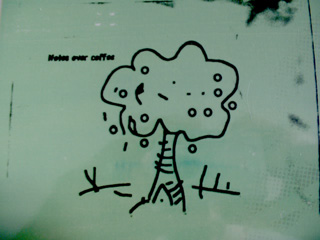
We printed the notes over transparent plastic and xeroxed the other notes and images and assembled them into a binder and jacket that we purchased from a supplier nearby. Joel is into kismet and tend to nix anything that even begins to strain with unecessary effort. We assembled the book and poof!, the time was gone and I was off to the opening at Chac Mool and to Z?rich afterwards. All during this time, I was thinking somewhere in the back of my mind of how to groom the project to a better place, that feeling of kerplunk!, you hit the bullseye.

Today, I have pulled the stewing ideas together. I thought it would be good to add an essay I wrote for one of Joel's other projects. It is entitled "Funny" and it is organized around change in my life and centered on the four years I had lived in ChinaTown, Los Angeles. I leafed the essay into the book and faced them behind the blank pages that punctuate it. My initial idea was to fade the text into grey to fit it into the fabric of the book... but I turned it green instead to echo the green printed rectangles within it. Then, I trimmed the punched margins of the plastic jackets and repunched them so they didn't hang out as they did before. It was tedious, and I doubt Joel will greet this detail with pleasure. I hope he likes the result and see that it is worth the trouble. Hell, he could hire an intern to do the tedium and rack up the cost into the publication price. We'll see.
Meanwhile, you can read the essay below. It's a little raw and confessional. I wanted to make it real. I signed it with my nom de plume (or nom de guerre), the name of the captain of my ship back in the sailor days. To my navy buddies who read this blog, like Gary Barnett, a tip of the hat to you guys:
funnyIt?s funny how things change. I guess the funny part is that we continually expect things to stay the same. Change then... in this light, looks strange, and strangeness is funny sometimes... when it?s not scaring you to death. Change is funny because it introduces the unfamiliar, and we can?t be comfortable with the unfamiliar because we don?t have a category constructed for it. Hell, the unfamiliar could be dangerous! Perils aside, funny isn?t always fun.
We left Los Angeles recently. My wife and I have lived in Los Angeles since college. We have both traveled a lot, our work has taken us all over the world, and now we are moving away. My wife has found better work in Texas. California has repelled business so much that her career ladder has led her out of the state. We?ll be back someday, but for many years, we will be away on an adventure.
Every time I return to Los Angeles, the city is a little different, no matter how long I?ve been away. We?ve been in Dallas for six months now, since we had moved from Echo Park. It will be two years shy of twenty since we arrived in LA with the intentions of growing roots. Little did I recognize then that this megalopolis is a desert by the sea. Plants grow shallow roots in the desert. Tumbleweeds abound. Winds shift the desert sands. Every time we come back, the place is different.
On this return, Los Angeles was comfortable, everything fit, everything had a feeling of gloved familiarity. Even the civic infrastructure was an old friend. Hello street lights,! Hello sidewalks! Hello curbs with all the cracks and roadways with all the potholes and blemishes! Hey guys, howyadoin? Whazzup, Santa Monica range! ?Sup 405? Still a parking lot, I see. Coming back from Dallas, flying into LA from 104 degree central Texas heat made SoCal seem like a paradise.
Dallas is best compared to the Los Angeles of Jack Webb?s ?Dragnet? fame. I couldn?t compare it to the LA of today, that would be cruel. If LA has twenty exciting and important social events going on in a week, Dallas has one. But Dallas has the same genetic structure as LA. It?s LA in the 60?s... ?lil LA. It?s got the same urban/suburban layout and spread, same freeway distribution. It has the same bad boy reputation within its? state. Driving is different, though. Texans drive cowboy style: either loping along or fast-right -on -your-ass giddy up, let?s get it on! You?ve got to jockey around alot in mixed company. Recent immigrant fluxes have modulated the traffic pattern a bit in Southern California, but usually, everybody is in a hurry and raging toward their appointments, there?s more flow. Even the traffic signals were welcome after Dallas, they?re timed faster. You can almost take a little cat nap while you?re waiting for the green to turn in Texas. It took a while for my right index finger to stop tapping the steering wheel involuntarily.
We were in Los Angeles, visiting my father in law who?s in the hospital. He has beat cancer twice before and he believed the doctor when he was declared ?cured?. Now that?s where the real problem started. Doctors used to be big shots, all knowing and the go-to experts on longevity. I grew up during the ?Dr. Kildare? years... now, I watch ?E.R.?. Being a professional meant a lot back in the day. But no more. Today, you?ve got to double check all the advice you get, or it?s your ass. He?s the last father I?ve got. My father and step father have both died within the past few years. I?ve always thought these times would come, just not this soon though.
Maybe you can sense change better when you?re older. I remember when I was a kid, the minute hand would take forever to go ?round, the hour hand was as fixed as the numbers on the dial. Christmas was so long away and summer would never end. And I remember thinking that my family would always be there for me. I could always call up my dad and hang out. There would always be time to see the Grand Canyon together, or go fishing. Then there was the day mom and dad took my brother and I into the living room to tell us they were divorcing. Funny... how things change.
The last time I visited our old home in Echo Park and my old studio in ChinaTown, things were different. The traffic was a bitch. ChinaTown had just added a metro rail train line station that linked it to Pasadena and Downtown LA. People were everywhere. The Chinese drive incredibly slow anyway, adding friction to the streets.. Lights would change and nothing would happen, crosswalks were packed with tourists and Asians. Or maybe I was going against the grain? I didn?t live here anymore, and I was moving outside the local urban pattern.
Traffic was like it was when I went to the airport during the last visit, two hours of thick city driving just to get to LAX. Of course, I cut through the most difficult cross section of the city: from the foothills in Tujunga on the 210 across the 105 to the 405 through the Santa Monica Range, crossing the 10 freeway down into the basin where the airport sits flat next to the ocean surf. That wasn?t a bright plan. When you live in this city, you learn the frictionless movement patterns and then life eases up... not for the visitors, though. They get all the friction and the tear of the cross cuts.
When I first rented a studio in ChinaTown, the place was forlorn, bereft of people. The big plazas were empty, save for the few lost and uniformed tourists. The merchants were at their wits end, tourists had abandoned Downtown LA for Universal city and Hollywood/Melrose. Faded newspapers would blow through the streets. They were running on fumes. Merchants would rearrange their goods on their shelves and talk of the good old days, the hey days when actors and actresses would be seen there, weddings and families would congregate in the banquet rooms. Now, touchingly clumsy bands with the guys in white pith helmets would march the funerals down Broadway. Many of the Chinese property owners? progeny had matriculated to other places, other cities. So the elders sat on their properties with no youngsters ready to take over the reigns. ChinaTown had become a ghost town in perfect aged pedestrian scale. Development in Los Angeles went West to the sea?s edge, where the parties were. Downtown Los Angeles tried and tried to rehabilitate to weak effect. Lots of empty restaurants, empty bars, empty storefronts...perfect for artists.
At first there were studios and artists. We rarely bumped into one another at the Chinese bakeries to get the terrible coffee there, or at the $3.75 lunch special restaurants where you don?t ask questions about the funny meat. Or maybe it was because I was a studio rat and had hermetically sealed myself into the studio? After some time, I was surprised to find the scene had composted into a hot little party place. Bars had swelled in Friday and Saturday population and the locals, Chinese and artists made friends. Galleries were places to hang out, more like a clubhouse.
And what fortune, there was an artist?s life in ChinaTown. Artists actually worked there, lived there. We got to know each other, warily at first. Then we soon gloried in the company of fools who would gamble that our curiosity just might be of some value to others soon enough in our life span that we might be able to forestall an early death suitable to those who would flaunt the common sense of simple survival. It was wonderful. Cheers, fellas.
There were musicians and bands and jam sessions and thankfully, nothing too polished ever emerged. What did emerge was a gallery scene after the loose affiliations became business partnerships and party decorations became art objects. By this time the word got out and dealers and gallery owners there started getting telephone calls asking where the next ChinaTown would arise in LA. ChinaTown as an art scene hadn?t yet begun and it was already deemed ?over? by the fashionably paranoid cognoscenti. What idiots.
The idiots came anyway. There are many art worlds and the ones who rely on ?fake-it-to-make-it? strategies slipped into the fabric of little ChinaTown. Arrivistes settled in and promoted synthetic versions of art. Surfer artists galleries attracted handsome and healthy artists. Intrepid art-technology pioneers attracted antisocial geeks. Environmental artist revolutionaries sought out the children to format their minds before the ?capitalist machine? devoured them, all this as they operated a neat little business procuring city grants for their operation. One lifestyle furnishings retail startup revamped its? premises on a collective opening night to simulate an art gallery to make a sale or two.
Art sharks began patrolling the galleries and bars. Dark leather jackets appeared in the smokey bars and the new patrons were the type whose eyes scan the bar population upon entry assessing the who?s who, exercising the not so subtle networking arts. Unlike the bars, galleries are stationary targets, dealers only have their receptionists and assistants to shield them from the predators. The really cunning sharks hunted in the guise as art world impresarios. WIthin the bars, they would buy the drinks and pass out the party invitations, holding court with artists hungry for the mysteries of success.
Then as the scene began to heat up and grow rings of change, the local ChinaTown business chieftains looked for the Asian face in the new ChinaTown. As elderly property owners retired and sold off their property, a few second generation offspring reinvested and reasserted their family businesses. Others opened up art galleries for local talent. Some opened up framing shops. A couple of twenty something clans opened up computer gaming parlors. One young group of law students even established their headquarters as a site for revolutionary change. They were crypto Marxists galvanized by ethnic solidarity, where the young ones would naively and cheerfully shout with little provocation: ?We?re going to change the world!? My skin would crawl. All this was going on, froth and ferment, and then the dot-com retired lawyers moved in. This, the completion of a robust cycle of gentrification. That?s when I left.
And now I look at ChinaTown from afar. Old coordinates fraying and yellowing with time. A snapshot of my past, dog eared with affection. Nothing lasts forever.
I grew up with change. I was a military brat. I lived in eleven locations around the world by the time I was fifteen. My dad had wanderlust, it ran in the family. I remember a story he told once, a picture snapped from a moment in his life. My grandfather met my grandmother as a traveling photographer, she was a daughter of a Texan family. They ran off together and the gleam of better prospects in his eye took them to homesteads all around the Southern end of the Mississippi River. And now, here is the snapshot: My grandfather loading up the wagon high with the family belongings, bound for a better future. The nine kids must have been around, not mentioned. The fields were robust with crops. And my grandmother silent, sitting atop the buckboard, tears streaming down her face.
My dad left that world of Southern depression by joining the Army. In his enlistment papers, his occupation was ?farmer?. He was sixteen when he joined, it?s hard to say that a person has an occupation when one is so young. He did pick cotton though. My uncle has a story of that time... something more than a snapshot and less than a story. They were picking cotton in the hot Missouri sun, hands cut and swollen, backs aching. My uncle founnd a rattlesnake in the row and boldly grabbed it by the angry tail. This would be no surprise if you knew the usual freaky gleam in my uncle Don?s eye. He then swung the snake around his head (and at this point in the telling of the story, the story teller must now simulate the motion bodily, complete with the freaky eye gleaming and all). And he snapped it like a bullwhip, thus tearing his skin off his body, further pissing the snake off in ways we can scarcely imagine. He then tossed the enraged reptile into my father?s cotton sack. Hilarity ensues.
These are stories my father would tell of his youth, tales that were originally intended to illustrate the hardships of a less fortunate time, lessons meant to compel my brother and I to quit whining and savor the good life we had. Too bad for thier intentions that they painted a such a wonderfully colorful world. It was the stories he didn?t tell that would mark me more.
He was not yet eighteen as his company was rushed into the Pusan Perimeter as the North Koreans rushed South to take the peninsula. After the Second World War, the Americans were weary of war. In five years, the military infrastructure had degraded and military readiness was shot. After the second world war... after the war to end all wars, America was reduced to heaving untrained men and sub par equipment to staunch the hemorrhaging last stand in mainland Asia. In the battle that would sear my father?s mind for the coming half century, they were surrounded on three sides and were wiped out. Bugles, tanks, artillery, human waves of screaming zombies. All but fourteen of his company were killed. They escaped, fording a river under fire and disappearing into the countryside, escape and evasion for three weeks.
He had nightmares every night for ten years after that. He built a brick wall in his mind against those days of his eighteenth birthday. This wall would begin to crumble fifty years later. He succumbed to flashbacks. They began as eyes staring at him, eyes he saw in the desert scrub surrounding his Arizona home. Later in telephone calls, he would stop and say: ?Did you hear that?? I would stammer. The desperation in his voice escalating. ?Squeaks! I can hear the squeaks!? Tank treads, the North Koreans didn?t have enough grease for their Chinese tanks. Then he would be in the thick of battle, screaming. And I was screaming: ?Papa! That?s not you! This is the year 2000! That?s not you!? And somehow it would work, and he would come back. Humiliated and fragile, he would try to laugh at the lame jokes I would try to summon up. I found the Captain of his company during this time through the internet, Captain john C. Hughes. Thank G-d for the internet. They were able to get together and savor the solidarity only people who shared war know. Brothers forever.
I was in ChinaTown when he took his own life. Rather, I was at home in Echo Park when the policeman came to the door. I thought the cat had tripped the home alarm one too many times. He said he was sorry but he had bad news. I had barely enough strength in my knees to get away from the front door to sit down on the back porch. It was funny in that unfunny way. Surreal. This isn?t me, is it? This doesn?t happen to me, can it? This couldn?t happen to him, could it? But the months of his illness told me otherwise. It was a few weeks shy of the fiftieth anniversary of that battle. Before, I thought suicide was a crime that one perpetrated against the people you love. Now I thought, how could I ever deny the only exit my dad had to escape his living hell?
I changed.
Things change, and these were the things that changed me in those four short years of living in Los Angeles? ChinaTown. I accept change, I grew up with change, there wouldn?t be life without change. I moved from school to school to school to school. I am change incarnate. I suckled the titty of change. But there?s still a small part of me that doesn?t want it. Maybe life finds this resistance to change, this treasured foolish stasis in our memories. Maybe each moment recedes into our memories, to lodge and to be dog-eared, elaborated, retold and the dust brushed off and rearranged on a shelf of treasures somewhere in our heads. Life becomes a train of adjustments to each new moment where we groom the unfamiliar into an old friend. And then the moment passes and the friend is gone and something new presents itself, this stranger. Maybe it is only in our imagination that we can find comfort . It is in this life, for this comfort, we are denied.
Is this right? No. Is this just? No. But we don?t live with righteous justice. We can only approximate justice in this life. We live in relation to it but we can?t merge with it. That?s the best we can do. The comfort of perfection lives in a far away place, and it is in this life here and now that we have to contend with the discomfort, the strangeness that each new moment brings. Kinda weird, change. That unfunny funny feeling.
-Billy Talley
October 2003
Dallas
October 24, 2003
Das Neue Aargauer Kunsthaus

I wanted to share these pictures form our visit to the opening of the Aargauer Kunsthaus in nearby (to Z?rich) Aarau, a train ride away. It's a museum devote to Swiss painting (although I think there might be exceptions to this rule). (I didn't get to the street for a camera shot, so this is a shot of the newspaper.) The collection is immense and it was great to see so many cool paintings.
I found a translated website at this address for your info:
http://translate.google.com/translate?hl=en&sl=de&u=http://www.ag.ch/kunsthaus/&prev=/search%3Fq%3Daargauer%2Bkunsthaus%26num%3D100%26hl%3Den%26lr%3D%26ie%3DUTF-8%26oe%3DUTF-8%26newwindow%3D1%26safe%3Doff


This is a shot on the roof, the path from the train station leads to the rear of the building. The architects: Herzog and de Meuron.

Coming in from the rear is probably the best way to go because you get to go down the spiral stair that's encased in green glass.
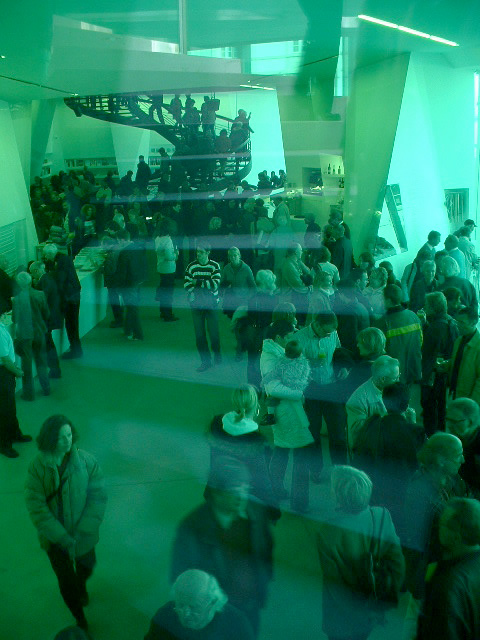
The roof as a social gathering space and the entry as a compressing vortex. The interior lobby walls are angled a little like Superman's Artic Fortress with twin spiral stair interior and exterior on each end. The interior wall finish was frosty like ice.

It was the opening weekend and the place was crowded. The museum arranged a dance company to enliven the place with static placements like this and dynamic showy pieces of girls in swimsuits and noseplugs in a Busby Berkely type routine. I was snapping pictures until I got busted by the gallery guards.
October 23, 2003
As for my show...


As for my show at Mark's space: I had the back room and a small installation as the introduction to the local community, in preparation for a bigger show next year. The drama of the shipment of the eleven works on paper was resolved (thanks to Mark's dexterity) but only two works were shown (the rest to be shown at the Cologne Art fair this week) and two larger paintings that belonged to the brace of work shown in LA at the beginning of the month.

These shots were taken at the end of the trip, a Sunday night after a wonderful dinner at Mark's sister's restaurant, and I insisted that Mark not worry about clearing the space out of the various clutter (he was preparing the works on paper for transprot to Cologne for the art fair).
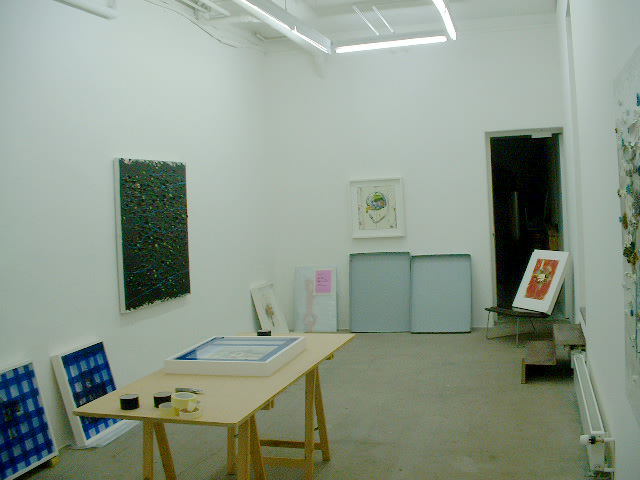
So, if you can imagine a spare room with two large and two small works hung symmetrically in a room entered assymetrically...
It's hard to see the opening where you would enter the room. These two doors shown are utility doors that are usually shut for the show.
Now, I'm really back.
Jet lag. The last couple of days have been verrrry sloooow. I've got much to assimilate in terms of what I've just experienced since the beginning of the month. I've got a pile of paperwork (files tax, art and otherwise) and the tasks required to get ready for the next brace of work in the studio. There's also next years' shows that I have to give careful consideration.

First things first: many thanks to Mark M?ller, who is and was very delightful, intelligent, considerate, attentive, insightful... a wonderful host for my work in Z?rich. This side view of him doesn't do enough justice to his visage, I'm still pretty awkward as a travel photographer... as you will soon see.
I arrived at Z?rich shortly before seven in the morning. The temperature was in the forties and the sky was overcast. Transit from the airport was easy as the train station was incorporated into the airport (as it should be in all major cities, DO YOU READ ME, LOS ANGELES?) and finding Mark's gallery was a delight since it was a short walk away from the main trainstation (Hauptbanhof).

This is the front of the building where Mark's gallery is located. To find the front door, you've got to go down the rabbbit hole...
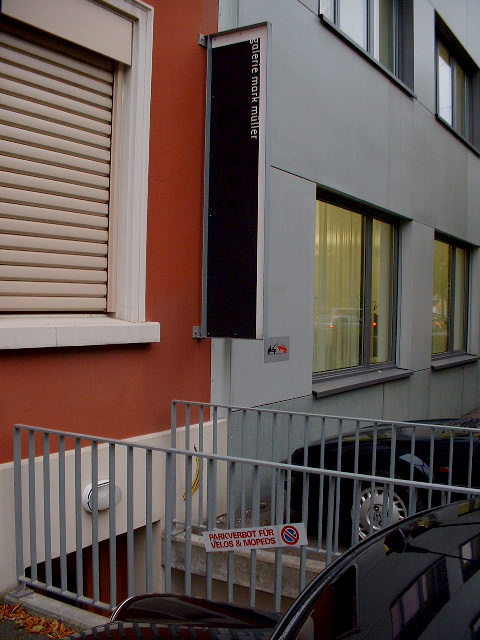
Here's the sign...

And here's the door.
A note on the rabbit hole: later that morning, I walked around Z?rich (I missed Mark who had come to the gallery early that morning to greet me... I walked the city in a big spiral, starting with what is known to them as a "rough" street (Lang Strasse, which is tame as urban roughness goes, nightclubs, sex shops and head shops), then crossing the river to the historical pedestrian boutique, bar and nightclub street (Niederdorf Strasse), then crossing the Quai Br?cke at the mouth of the See Lake to return to the gallery via Bahnhof Strasse, the corollary to Beverly Hills in LA. All of this is to say that compared to other possible locations of urban sites in Z?rich, Mark has sited his place very well: tucked beneath (literally) the edge of the heart of the tony part of town. Edgy yet upscale and finally edgy. And now, the gallery:
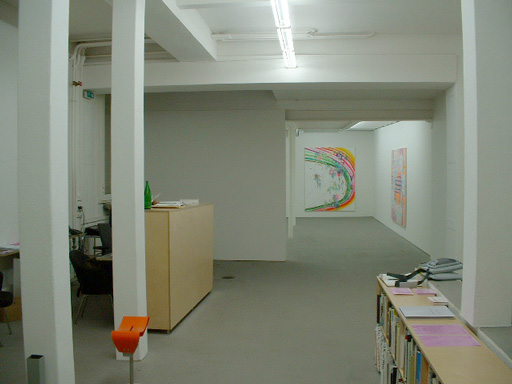
You will be seeing Christine Streuli's show.
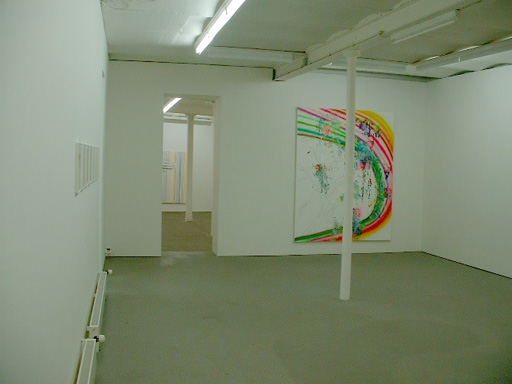
Christine is a young Swiss painter, just out of school and burning with that magic that few are blessed with as she has already been to New York, Cairo and has had a few paintings incorporated into local museum collections.

As you can see, she has an eclectic pallette, sampling from many techniques and many influences. Talking to her, I found she thinks poetically, correllating symbolism to technique from canvas to canvas.

October 22, 2003
I'm back!
I got back from Z?rich late Monday night and the day after was so jet laggy slow. Today is too, but a little better. I've got a few pics and much to say... to come inthe next few posts. It's good to be back home with Stephanie.
October 14, 2003
I'm Flying Outta Town
I'm scooting out of town, bound for my first show with Mark M?ller Gallery in Z?rich, my first gallery show in Switzerland. Mark is breaking me in with an introductory show in the second gallery space, a bigger follow-up show to come later.
The drama of last week was the late delivery of eleven works on paper that I had sent to Z?rich from Dallas via US Postal Service's Express mail. It had worked like a charm when I sent similar works to other galleries in the EU. I have sent them in this manner in the past because it was inexpensive and I could build a strong traveling box wo the work can survive the journey... and as they arrived at the galleries without much effort on their part, the delight factor is high as they arrive... I hope.
What I knew but didn't consider carefully enough is that Switzerland is not part of the EU, and what I couldn't know was that Switzerland will not accept "artwork and weapons" into their country via USPS. The post office didn't tell me. So, as the Swiss were about to load the boxes onto a cargo container to ship back to me here in Dallas, Mark figured out how to work around the problem and he was able to get the work into the country at the last minute.
Whew!
I was holding my breath all week, and the whole thing set a cloud over my head the whole time. Now, I can relax and enjoy the show.
Meanwhile, my dealer in Cologne is going to show the two black paintings shown in previous posts and he has news of the strong possibility of showing with a gallery in Amsterdam. Great news, huh? Our upcoming move to Spain is looking good.
See you all later with pics from Z?rich!
Greg Colson

Greg was generous to drive over to our hotel for breakfast the morning after the opening. This is at the Mondrian Hotel, nice digs, expensive breakfast. We had a great time talking and catching up.
Greg is a fantastic artist. I really admire his work, stuff that I think is conceptual, formal, nuanced and made with a unique hand and sensibility. We went to the same grad school (at different times), and he's the kind of alum that can make you proud. He's the kind of artist friend who makes you strive harder.
I lifted a couple of images from his gallery's website, Speroni Westwater:


And here's a couple more from ArtNet:


Joel's studio

Joel inherited my old studio, and here, we worked last week on a print project. It is a tribute to the Newton MessagePad 2100, as the images generated on it were faxed, xeroxed, printed with an offset printer, then mixed and matched into a near narrative that's not supposed to be read as appreciated for it's formal qualities.
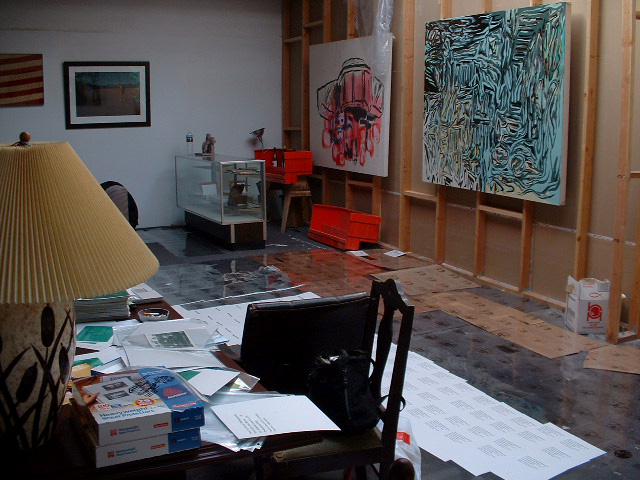
This is scheduled to come out at the end of the month.
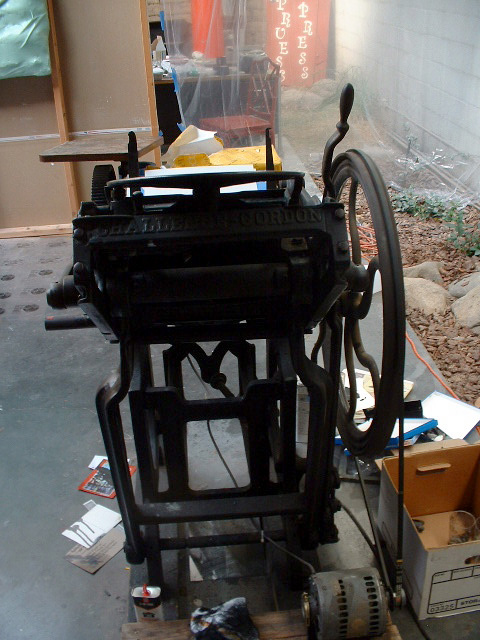
There's still some fine tuning to be do yet, long distance.
Phil's Place

I wanted to show you guys a couple of pics from Phil Wagner's studio in ChinaTown. Phil works with enamels in this imagist mode, this time with an all over strategy that laces lines into forma where the point of view is up so close that figure is the field.
er, I guess you can see that...

Phil works for Jorge Pardo, fabricating and designing the stuff the great PArdo is known for. Bart Exposito has a studio next door and Bart has been telling everyone in LA about Phil's recent series. You guys get a peek.
Dinner at Estella's

On the last night in Los Angeles, Estalla threw a very delicioius dinner at her house. I don't want to show too many pictures of her place, it's best to keep her privacy. Stephaie and I had a gret time and were gratified by Estalla's generous hospitality. We hope to reciprocate one day for her in our place in Tossa one day soon.

October 13, 2003
Shipping

Two paintings are off for Andr?'s gallery, bound for the art fair in Cologne.
The art handlers from Displays Unlimited are on time and on target. So far, so good.
The show at Chac Mool



I've returned to Dallas after my week in Los Angeles. I'll relate the events of the week in subsequent posts. The images above is the installation of the show in Chac Mool, my gallery in LA. Sorry to say that I have no pictures of the opening, I was engulfed in well wishers and friends, a very wonderful night.
Cheers to Estela Provas, Eugenio Lopez, Samantha and Talar who have done very well for me and the work.
The only cloud over the week was an ongoing problem with my shipment of works on paper to my first show in Z?rich with Mark M?ller Gallery. I had shipped eleven works via the US Postal Service Express Mail. Now, I learn that Swiss Custom have banned "artworks and weapons" via USPS shipping into that country.
Hmm. That's a good name for a piece.
More to come, I'll keep you posted. Mark M?ller has figured out how to get them diverted to a town in Germany. Keep your fingers crossed, maybe we can get them into the show after all. Pins and needles.
Anyway.
Here's the installation at Chac Mool:

Left

Middle

Right
October 5, 2003
Late Saturday Night

The second of the two paintings that I wanted to complete before I leave for Los Angeles is done. Heaping mounds of paint were required.

With this one, I wanted it to follow the last and yet be specific to its' own argument. The trajectory towards a field was broken for something more linearly horzontal. (This makes sense to me, I hope it does for you too.)

It takes many types of shots to get this one through the camera.

The black field foreclosed any dynamic of linear vs flat marks on the canvas. The best thing to do is make the field as vibrant as possible, to make black as a color as lush as possible.

I've got a lot to figure out in this camera, especially in terms of field of focus.
October 3, 2003
WooHoo

I'm looking at the advertisement for my show in LA by Chac Mool, it's on page 81, my first full page in ArtForum. I'm stunned.
Thanks, Estella!
I like especially, that Francis Bacon is on the cover of the accompanying Book Forum. I trace my work to several roots, chief among which in tandem with Goya is Bacon.
I remember the show of his work at the Los Angeles County Museum. Standing before his work, I remember the revelation of being able to count his moves: the architectural interior box, the schematic lines, the smooth colored areas, the smooth torsional blends, the impasto smear, the print (of a shoe?), the stamped circles, the typographic rubs, the spray, the fling, the bare canvas...
Good company, good fortune.
October 2, 2003
Alla Prima Quickstep
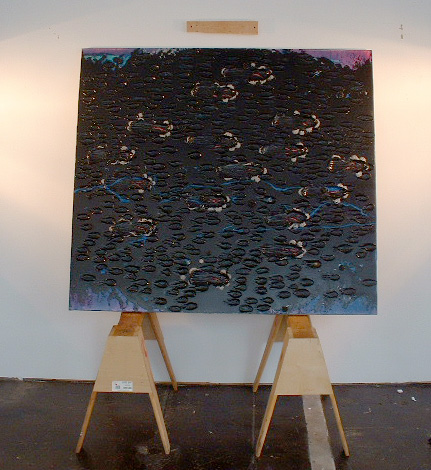
I've just finished one of two paintings I want to tackle before I leave for Los Angeles next week. These are painted on the panels shown in the recnet posts.

It's black painting along the lines of the one called "Silent" (posted 16 September, "Weekend Warrior"). As a black field painting, it's a hard one to photograph. I usually take some satisfaction in the ability of my work to evade the camera (with mixed feelings), and this one does as much as the others or more. This shot is a raking shot, the perspectival forces hidden by the crop.

As an alla prima method, I want to paint in the wet state of the paint. I like the test of it all, the clock ticking, decisions have to be made. This is in the face of the kind of work I used to find in my post art school context: artwork that's more of a fabrication, whose conceptual coordinates are plotted and decisions are largely made before you saw the artwork itself.

The thing is that inthe early days, I started with work that was painted with colors that took the longest to dry. And now, as I'm painting with darker colors, like black and umbers.... these colors dry fast, forming skins within twenty four hours, and sometimes sooner, if the cross section is thinner... twelve hours.

All of this brings me full circle a little: I'm spending some time, more time, before I lay paint onto surface... thinking about how I'm going to go about it. I'm painting it a few times in my head, like planning chess several chess moves into the game. And no matter how many "chess moves" I plot, I have to be able to abandon the plan for the facts on the ground as I find myself into the middle of the experience.




